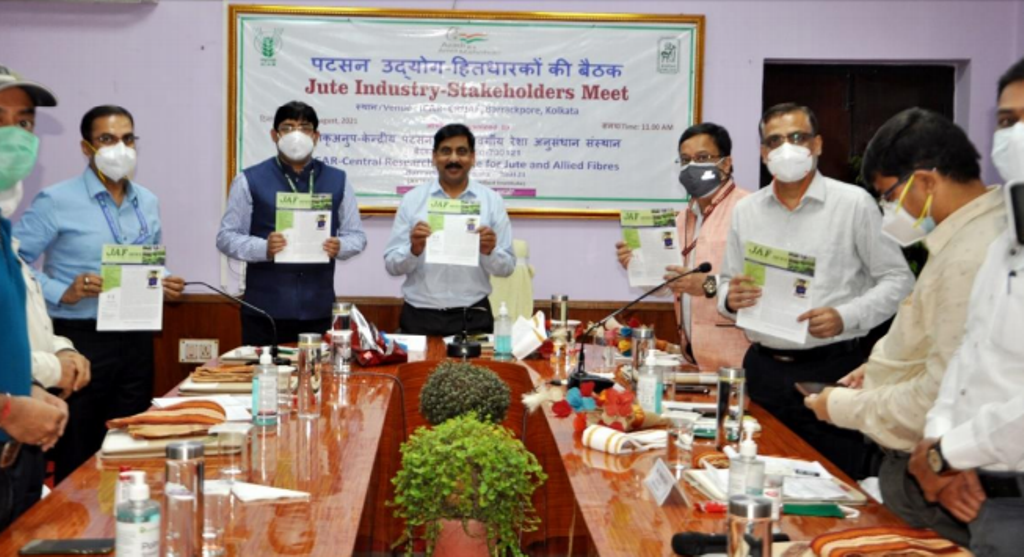
ICAR-CRIJAF is continuously pursuing excellence in research and technology development for the benefit of the whole jute sector by strengthening the fibre production technology with new innovations.
Recent developments in need-based technologies developed by the institute on improved varieties with higher productivity and finer quality, mechanization in jute cultivation and post-harvest processing, solar energy based free flow water retting, liquid formulation of microbial consortium ‘CRIJAF SONA, in-situ retting tank and eco-farming will certainly give a new dimension to jute production and post-harvest processing for obtaining high quality fibers for manufacture of export quality jute diversified products.
To appraise and showcase these technologies, among the stakeholders, particularly the jute industries, the Institute organized “Jute Industry-Stakeholders Meet” on 28.08.2021. At the outset, Dr. Gouranga Kar, Director, ICAR-CRIJAF, Barrackpore welcomed the guests and told about the importance of such meet. In his welcome address Dr Kar highlighted about advancement of new cultivation and post-harvest technologies of jute among all the stakeholders involved from farming, processing, manufacturing, policy making to marketing and export.
Keeping in mind the requirement of superior grade jute fibre to compete in the international market and to meet the demand in the domestic market the recently developed technologies of CRIJAF will boost the jute sector by augmenting quality, productivity and profitability. He also emphasized to promote other allied fibres like flax, ramie, sisal and sunnhemp which have economic and ecosystem services values and can be suitable substitute of plastics and synthetics.
U.P. Singh, Secretary, Ministry of Textiles, GoI graced the occasion as Chief Guest. In his address, the Secretary expressed that this is the right time to revamp and promote the jute sector in every front. In this direction, the technologies developed by ICAR-CRIJAF will be very fruitful for import substitution and export promotion. Presently, India has technologies and varieties with high productive potential (40 q/ha) and best fibre quality (comparable to TD1 and TD2) which needs to be promoted.
He also appreciated the result of demonstrated technology of jute sector on improved retting like in-situ water conservation, slow moving water system, liquid CRIJSAF SONA etc. to provide best quality fibre keeping in mind the climate resilience of the technology and to produce better grade fibre. He also urged industries to promote best technology of jute production to get better quality raw material for providing export quality jute diversified products which has higher demand in International market.
C. Chakraborty, Jute Commissioner and Mr. A. K. Jolly, Managing Director, Jute Corporation of India, Ministry of Textile, GoI were the Guest of Honour. They expressed satisfaction about the new initiatives of ICAR-CRIJAF for improved jute retting and told that specific policy backup is needed to get the outcome in the field in shortest period of time. They also opined that the concerted and coordinated programme implemented by ICAR-CRIJAF, JCI and NJB have resulted in higher productivity and quality of jute in current cropping season of 2021.
The guests and delegates visited the exhibition hall and the fibre museum for first hand appraisal of the technologies, fibres of jute and other allied fibre crops, jute products, retting prototypes etc. The dignitaries also visited different models of in situ retting tank and solar operated slow moving retting water facility in the newly developed retting complex of the institute.
Altogether 30 participants from jute and allied fibre industries, Ministry of Textiles, State Govt. and ICAR scientists participated in this meet. The industry delegates expressed that the jute farmers should go for adoption of CRIJAF technologies that will certainly benefit the jute industries and the raw jute sector in totality.
















